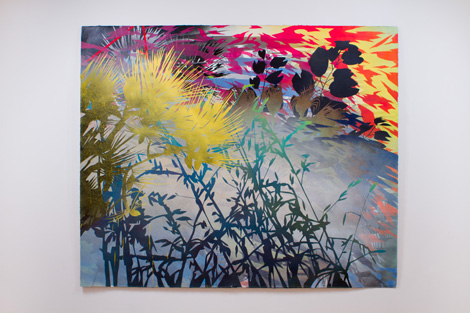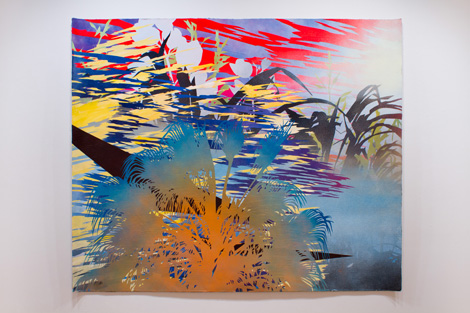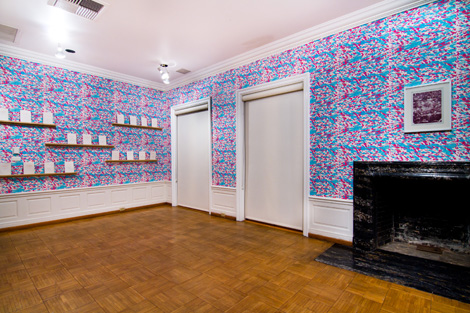Environmental undertones, bright poppy color and a sense of collaboration create a striking combination for Devon Tsuno’s exhibition “Watershed,” which is split into two distinct sections. Tsuno is native to LA and an educator enamored with the Los Angeles River system.
Six new paintings in Tsuno’s trademark style are intensely colored, heavily process-laden, with abstract and vegetative imagery that crossover from fine art to stunning design, and seamlessly back again. The far end of the traditional white cube gallery is dominated by two large format acrylic and aerosol paintings: Agglomerate Horticulture (2013) and South of Fletcher (2013–14), the latter referring to the section of river near Frogtown. Each is done on a single sheet of handmade Japanese Washi paper, a nod to his Japanese heritage.
The large works transition impressively from the macro to the micro, graphic and striking from a distance, but at close proximity revealing dozens of intimate layers of stenciling, taping, masking, covering and re-stenciling, as if they were a raised topographic map.
To call the works abstract or simple landscape paintings would neither be correct nor far from the mark. In reality, they are imagined geographies made by collaging imagery from photographs taken while exploring the Los Angeles watershed. Vibrantly colored, camouflage-esque backgrounds conceptualize images of rippling water running down the concrete riverbeds, while the boldly stenciled organic shapes indicate non-native plant species. Flatness, distortions of scale and numerous layers of visual imagery begin to play with the viewer’s perception of foreground and background, causing a beautiful disorientation.
Tsuno’s bright pink and teal, digitally-printed wallpaper designed from river water imagery covers an adjoining room of the “Watershed” exhibition, transforming it into a homey den environment, where a multitude of books produced in conjunction with the Occidental College book arts program are displayed. Tsuno produced editions of Risograph prints, each given to 20 students who reordered the prints and added text that responded to the foreword written by Jon Leaver. Each student’s unique book was then hand-bound in an edition of three.
Opposite the book wall exist multiple precarious stacks of handmade wooden milk crates, containing thousands more Risograph prints in varying colors. With abstracted imagery of rippling water, they combine facts relating to LA population and total precipitation during 2013. Tsuno follows a marked tradition of the art “take-away” to represent loss or exhaustion of something precious. To Felix Gonzalez-Torres, candy was a metaphor for the deterioration of his partner’s body due to a terminal illness; for Tsuno, giving away prints symbolizes the depletion of LA’s natural resources coupled with the strain of rising population.
While many Angelenos speed down the freeways, crossing over the concrete channels that once were thriving environments, in “Watershed” we are left to contemplate how nature exists here. Artist-adventurers like Tsuno help to bring attention to this fact and remind us of the hidden ecosystems all around the city that are deserving our attention.




